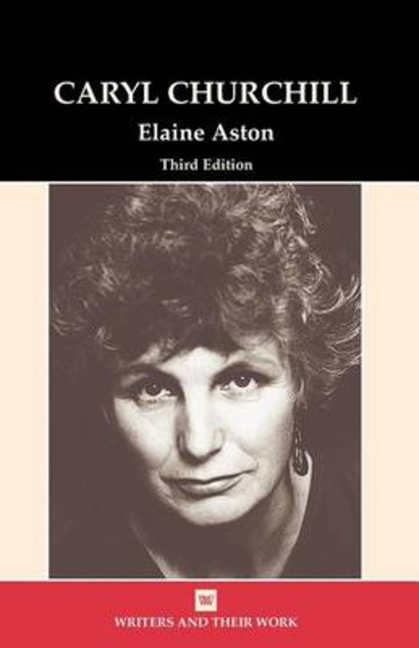Book contents
- Frontmatter
- Dedication
- Contents
- Acknowledgements
- Biographical Outline
- Abbreviations
- Preface
- Prologue
- 1 Beginnings: Radio, Stage and Television
- 2 The ‘Woman Writer’
- 3 The Dramatist as Socialist Critic
- 4 Communities in Dramatic Dialogue
- 5 Exploding Words and Worlds
- 6 1997 - Far Away
- 7 A Royal Court Celebration
- Notes
- Select Bibliography
- Index
5 - Exploding Words and Worlds
- Frontmatter
- Dedication
- Contents
- Acknowledgements
- Biographical Outline
- Abbreviations
- Preface
- Prologue
- 1 Beginnings: Radio, Stage and Television
- 2 The ‘Woman Writer’
- 3 The Dramatist as Socialist Critic
- 4 Communities in Dramatic Dialogue
- 5 Exploding Words and Worlds
- 6 1997 - Far Away
- 7 A Royal Court Celebration
- Notes
- Select Bibliography
- Index
Summary
'Playwrights don't give answers, they ask questions’, wrote Churchill in an early essay on theatre. She continued: ‘We need to find new questions, which may help us answer the old ones or make them unimportant, and this means new subjects and new form’. The kinds of questions which Churchill asks through her theatre reflect her feminist and socialist viewpoints, but allied to her interrogative, political mode of writing is her experimental approach to dramatic and theatrical form. Churchill's theatre is not just a question of politics, but a politics of style.
This chapter seeks to highlight Churchill's experimental approach to theatre-making by examining her interest in the defamiliarization of our twentieth-century fictions or systems of illusion-making, which she encodes thematically (subject) and stylistically (form) in a range of plays. In particular, it examines Churchill's deformation or explosion of the word, of language, the sign-system through which we mediate and make sense of the world, whether this is in the context of postmodern culture, as in her late 1980s play Icecream, or the mythological underworld of one of her more recent, iconoclastic productions, The Skriker (1994).
By way of introduction, I wish to return briefly to an earlier period of Churchill's work: specifically to Traps, written in 1976 along with Vinegar Tom and Light Shining in Buckinghamshire, which shows Churchill's early preoccupation with manipulating sign-systems; with ‘unfixing’ the boundaries of illusion and reality. In the uncertain, unstable, and violent dramatic world of Traps, Churchill violates the illusion- and reality-making rules to create a ‘reality’ that has no existence other than on the stage, like ‘an impossible object, or a painting by Escher, where the objects can exist like that on paper, but would be impossible in life’ (PI 71). The dramatic world of Traps operates through signsystems which are constantly destabilized: a group of six characters gather in a room which is urbanly and then rurally located; a door which opens for one character appears locked for another; clothes which we see being ironed are re-presented in a crumpled state for ironing; a bowl and plant, which get broken and destroyed, reappear as new; a woman with a baby speaks of not having a baby, and a man talked about as dead walks into the room alive.
- Type
- Chapter
- Information
- Caryl Churchill , pp. 80 - 102Publisher: Liverpool University PressPrint publication year: 2010



